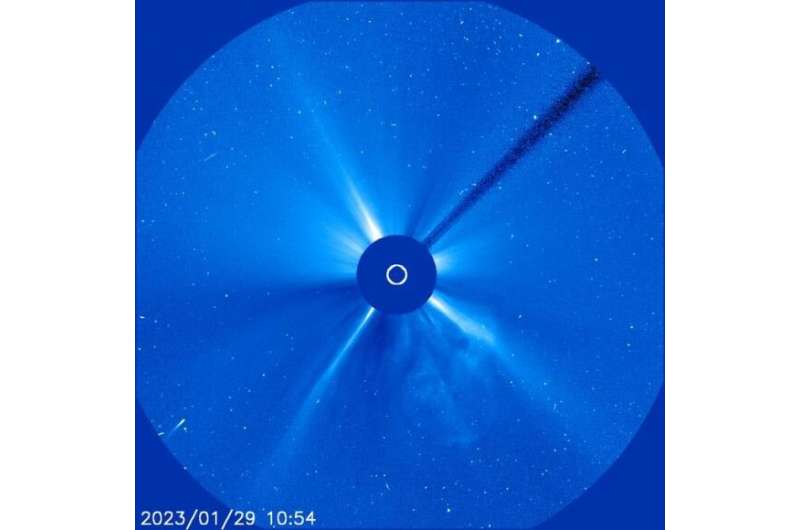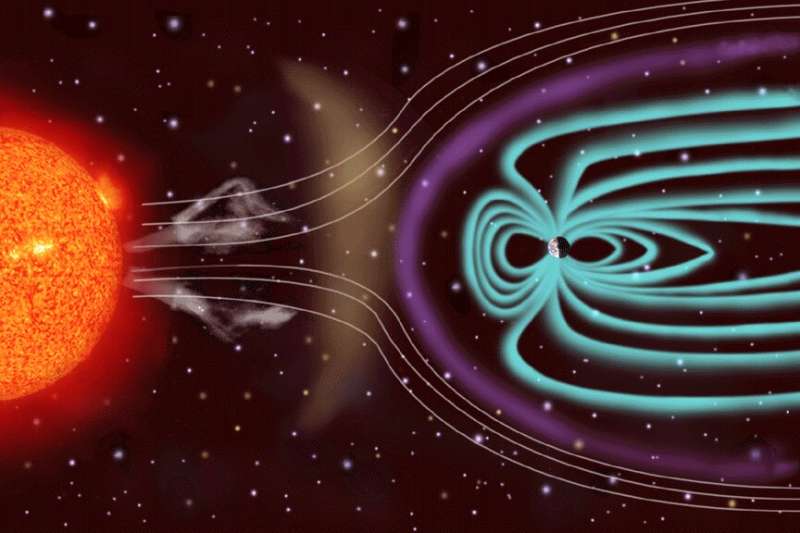This article has been reviewed according to Science X's editorial process and policies. Editors have highlighted the following attributes while ensuring the content's credibility:
fact-checked
preprint
trusted source
proofread
Now we know how a solar storm took out a fleet of Starlinks

On March 23, sky observers marveled at a gorgeous display of northern and southern lights. It was reminder that when our sun gets active, it can spark a phenomenon called "space weather." Aurorae are among the most benign effects of this phenomenon.
At the other end of the space weather spectrum are solar storms that can knock out satellites. The folks at Starlink found that out the hard way in February 2022. On January 29th that year, the sun belched out a class M 1.1 flare and related coronal mass ejection. Material from the sun traveled out on the solar wind and arrived at Earth a few days later. On February 3, Starlink launched a group of 49 satellites to an altitude only 130 miles above Earth's surface. They didn't last long, and now solar physicists know why.
A group of researchers from NASA Goddard Space Flight Center and the Catholic University of America took a closer look at the specifics of that storm. Their analysis identified a mass of plasma that impacted our planet's magnetosphere. The actual event was a halo coronal mass ejection from an active region in the northeast quadrant of the sun.
The material traveled out at around 690 kilometers per second as a shock-driving magnetic cloud. Think of it as a long ropy mass of material writhing its way through space. As it traveled, it expanded and at solar-facing satellites—including STEREO-A, which took a direct hit from it—made observations. Eventually, the cloud smacked into Earth's magnetosphere creating a geomagnetic storm.
How Starlink satellites experienced the effects space weather
One of the side effects of space weather that can affect satellites is warming in a region called the "thermosphere." That increased the density of the upper atmosphere over a short amount of time and caused it to swell up. A denser atmosphere causes a phenomenon called "atmospheric drag." Essentially, the thicker atmosphere slows down anything moving through. It also heats things up.
The atmosphere thickened enough that it affected the newly launched Starlink stations. They started to experience atmospheric drag, which caused them to deorbit and burn up on the way down. It was an expensive lesson in space weather and provided people on Earth with a great view of what happens when satellites fall back to Earth. It was also that could have been avoided if they'd delayed their launch to account for the ongoing threat.

How does space weather work?
The sun constantly sends a stream of charged particles called the solar wind. This stream varies in density, speed, and temperature. Occasionally, the sun will also belch out clouds of plasma in what's called a 'coronal mass ejection." Sometimes it also sends out solar flares. All the material it loses travels away on the solar wind.
During periods when the sun is more active, those clouds of plasma can come pretty frequently. If they impact Earth, the results can vary from a pretty auroral display all the way to commercial satellite disruptions and power blackouts on the ground. The loss of the Starlink satellites was a particularly massive effect of space weather.
Current space weather effects
At the moment, the sun's activity is increasing as it heads into a period called "solar maximum." We can expect more auroral displays, along with CMEs and flares. With the strong outbursts come threats to our technology. Obviously, communications and other satellites are in danger. So are astronauts on the International Space Station.
But, the threats aren't just in space. Earth-based power grids, communication lines, and other technologies are also at risk. For example, when a geomagnetic storm hits, it sets up huge circulating electrical currents between Earth and space. These are called "geomagnetically induced currents." At the very least, they can short out power lines and grids. When those go down, so do the Internet, computer systems, telephone systems, and other crucial services. The average person would immediately experience a power outage, at the very least. But, airlines, banks, and other systems would be down until power and communications could be restored. There's a great need to strengthen our technology against solar storms.
Starlink lessons learned?
The loss of the Starlink satellites cost the company millions of dollars. The company elected to launch, even though the space weather community warned about the effects of a geomagnetic storm. For years now, solar physicists have been warning about the effects of space weather. Most satellite companies pay attention to reports from such places as the Space Weather Prediction Center. If they get enough warning ahead of time, they can take steps to protect their equipment. Astronauts on the ISS can take shelter until the storm passes. And, power companies and others can follow forecasts of such storms so they can take whatever action is needed in the event of a strong event.
Solar physicists continue to study these solar outbursts in hopes of coming up with a foolproof prediction system. At the moment, when something erupts from the sun, we get notifications from a fleet of satellites. Those give us minutes to hours of "heads-up" time to prepare for the worst. NASA and other agencies continue to improve solar studies and prediction methods so that companies launching satellites to low-Earth orbit can take steps to protect their investments.
More information: Nat Gopalswamy et al, The Solar Cause of the 2022 February 3 Geomagnetic Storm that Led to the Demise of the Starlink Satellites, arXiv (2023). DOI: 10.48550/arxiv.2303.02330
Journal information: arXiv
Provided by Universe Today





















